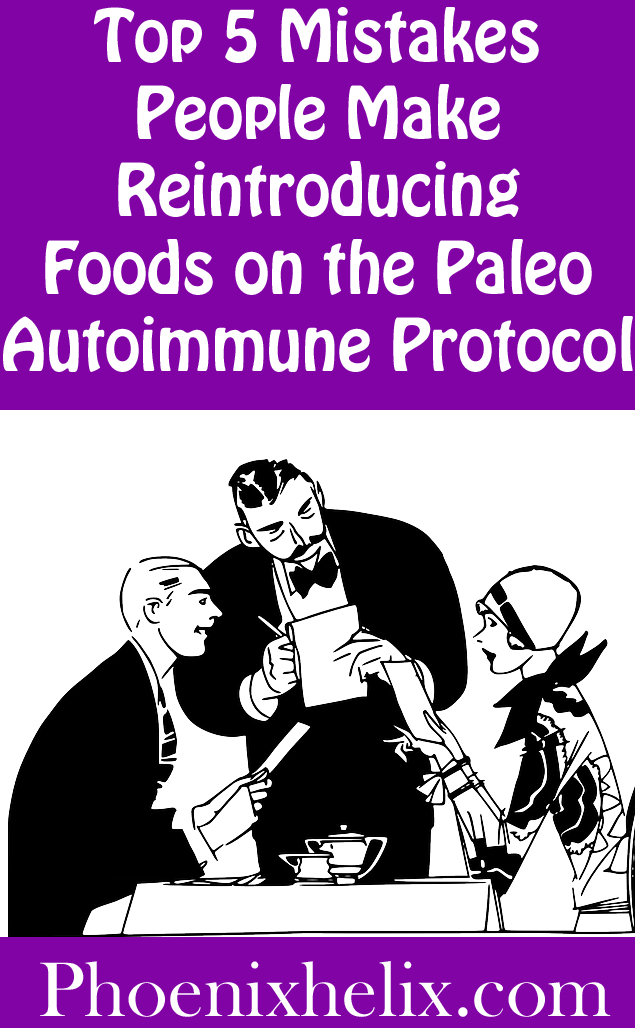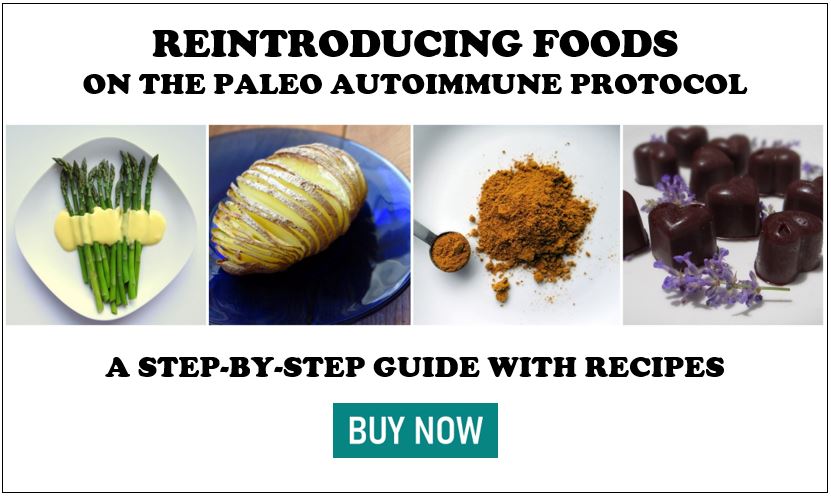
“Success does not consist in never making mistakes but in never making the same one a second time.”
~ George Bernard Shaw
1. Doing Them Too Soon, or Not Doing Them At All
The Paleo Autoimmune Protocol (AIP) has two phases. Elimination and Reintroductions. The elimination phase lasts a minimum of 30 days, but some people do it longer. How long should it last for you? That depends on two things: First, you want to see clear improvement in your autoimmune symptoms before beginning the reintroduction process. That’s how you’ll be able to tell when you’re having a food reaction – it will cause symptoms to reappear temporarily. If you haven’t seen any improvement yet, you’re flying blind.
Second, you want to be emotionally ready for reintroductions. Some people feel so good on the AIP that they fear the reintroduction process. It’s OK to wait until you are looking forward to expanding your diet again. Just be sure to focus on nutrient-density in the meantime, eating as wide a variety of foods as possible within the AIP template. However, strict AIP isn’t meant to last forever. The more restricted our diet, the greater our risk for developing both nutrient deficiencies and disordered eating patterns. So, make it your goal to do reintroductions at some point.
2. Rushing the Process – Skipping Phase 2
You can find the steps to the reintroduction process here in this article. First is a series of tiny bites, then you wait a few hours. If you have no reaction, you eat a normal portion of that food and wait 72 hours. If you still have no reaction, you move onto phase two and eat a little bit of that food every day for a week. This last step is the one many people skip, which is a mistake.
Food intolerance seems to come in two forms. (1) A strong reaction, where there’s no doubt that your body reacts negatively to the food. (2) A cumulative inflammatory response that starts off so mild you can miss it at first, but it becomes noticeable after daily consumption. If you’ve done reintroductions and skipped phase two, then noticed your inflammation ramp up after reintroducing a variety of foods, this is why. Phase two allows you to identify the foods you can have occasionally but not daily. It also allows you to identify the successful reintroductions that you CAN have every day. For example, I can eat eggs daily, but I can only eat nuts occasionally. I wouldn’t know this if I skipped phase two.
3. Involving a Restaurant
It can be tempting to go off-diet when people invite us out to dinner, or there’s a big event like a wedding that we want to attend and not worry about food. Some people say, “Well, I’ll just treat it like a food reintroduction.” I’m sorry, it doesn’t work that way.
The reintroduction process is a science experiment, and it’s important to control the variables. That means you need to be the chef, and you need to be in your own kitchen. You only want to reintroduce one new food at a time. That’s the only way to tell whether or not a specific ingredient is good or bad for your body. Even if you choose just one ingredient to reintroduce when ordering at a restaurant, you have no way of knowing what other hidden ingredients might get added by the staff. So, instead, eat AIP when you’re at restaurants or events, and save your food reintroductions for home.
4. Choosing a High Stress Time
It’s easy to forget that the AIP isn’t just about food. It’s also about lifestyle. Stress and lack of sleep can cause autoimmune flares just as much as food can. So, you don’t want to combine these forces. Your best chance at successful food reintroductions is to do them when you’re feeling great emotionally as well as physically, with lifestyle habits that support your health. In fact, I recommend meditating (or relaxing in other ways) during the reintroduction process, to enhance this effect.
5. Bingeing
Sometimes, when we go a long time without eating a good, we get overexcited about trying it again. There’s also the fear that the reintroduction might fail, so we want to eat as much as we can while we can. Here’s the problem: Our bodies aren’t designed for bingeing. If you eat a huge amount of ANY food, your body is going to rebel. Readers have said to me, “I’m so sad, my chocolate reintroduction failed!” I asked them what they ate, and they said “Brownies! They were so good, I ate the whole pan.”
My friends, that’s not a failed reintroduction – that’s a guaranteed inflammatory response from too much food at once. So, when you do a new food reintroduction, eat a normal size portion. Remember, the goal of the reintroduction process is to gain knowledge about our bodies, and it’s priceless to have.
Review Roundup
I’ve been lucky to have a lot of people fall in love with this guide and write about it:
“Eileen’s approach is gentle yet comprehensive, leading readers on how to be best equipped to embark on a process that takes a lot of intuition and care to do properly….What I love about Eileen’s book, is that she shares recipes that include the staged reintroduction foods, but one at a time! For instance, one of the first foods people can reintroduce is egg yolks, so she includes a recipe for hollandaise (including a link to a video of how to properly separate the yolks and whites–how cool is that!).”
~ Mickey Trescott, Author of The Autoimmune Paleo Cookbook
“Science is awesome, but for me to really get into something, I need some ‘data with soul.’ Eileen shares her own healing story with us & includes a sample reintro journal. Had I read something like that at the start of my reintroduction attempts I would have been so much less confused about what my own process might involve. I’d have had the hope of healing from Eileen’s own story and, most importantly, I would have understood how much time I need to invest.”
~ Angie Alt, Author of The Alternative Autoimmune Cookbook
“I especially love the sections that – surprisingly – AREN’T about food. Managing an autoimmune disease is much more complex than dealing with diet alone and can be a frustrating and emotional experience, especially when sometimes we’re left feeling like our bodies are rebelling against us. Eileen’s understanding of those feelings is wonderful and she walks you through the emotional aspects of reintroducing foods as well as the practical concerns. Most importantly, to me, she reminds us all that there is hope and positivity to be found along the way.”
~ Rachael Bryant, author of the cookbook, Nourish
“The AIP reintroduction protocol can be tricky, as there are so many foods to evaluate, and reintroducing them one at a time can be difficult. Until now, there hasn’t been a book devoted just to this part of the protocol. After reading Eileen Laird’s e-book, we realized this was the piece so many of you were missing.”
~ Melissa Hartwig, Author of It Starts with Food and The Whole30
“If you’ve been on the autoimmune protocol for a while and think you’re ready to start reintroducing foods, this guide is a fantastic resource to help you decide when to start, which foods to start with, and make sure you get it right the first time by providing recipes to guide you through the process.”
~ Christina Feindel, at The Paleo Mom
“I tried a couple of reintroductions a month ago and it didn’t work, even though I thought I was being careful. I’m reading your book and I see what I did wrong. Your diary of introductions really hit home. Thank you for putting this ebook together, it’s already taught me a lot.”
~ Meredith, blog reader
You May Also Be Interested In
Credit: image at top of page from Pixabay.










I started strict AIP (before that I wasn’t even Paleo) in September, and I’ve now reached stage 4 of reintroductions. My question is: So far all the peppers and nightshade spices I’ve tried have been fine (paprika, red bell peppers, cayenne, chili powder, jalepeno … how much do I need to break this down, what all else do I need to test/reintro before I can safely say that, at least as far as I know, all peppers are OK? The only nightshade that’s given me trouble so far is white potatoes. I mean, I can try the curry powder we have in the drawer, but that doesn’t necessarily have the same ingredients as every other curry powder, since it’s a blend. So would I be able to eat a curry at a restaurant, assuming all the other things are OK? Thanks.
Hi Word Lily. I would say hot peppers are a successful reintroduction category for you, which is awesome! Enjoy! Curry should be fine, so long as you also successfully reintroduced the seedbased spices. When in a restaurant, I also clarify with the staff that everything is gluten-free, since that’s added in the strangest places for added taste and texture, and might somehow be added to the curry in a different way. For example, white wheat flour is often added to white rice in restaurants to make it “stickier”. Crazytown!
Thank you! I’m quite accustomed to verifying on the gluten free question; I’ve been GF for more than 8 years, since I figured out I have celiac.
Eileen,
I’ve been following a strict AIP for just over a year now. My symptoms (which I didn’t even know I had) cleared, but after 3 months, 6 monts and again at 10 months I had no reduction inantibodies, instead it rose!
And now some symptoms returned, without changing a thing in diet.
Can I reintroduce or do I have to keep on searching for possible causes until my antibodies drop?
I am looking into toxicity (esp amalgam fillings, crowns, cavities etc) now.
Marelize, you don’t have to be in remission to reintroduce foods. The best timing to have done it was when you were feeling your best, because that gives you a baseline for food reactions. Food is one part of the healing puzzle, but not the whole thing. Reintroductions won’t set you back in your healing; they simply help you personalize your healing diet for you, with as expansive a diet as possible. Regarding troubleshooting your new symptoms, I have an article that talks about the functional medicine tests and treatments I believe are most helpful: How to Find a Good Functional Medicine Practitioner. Once your symptoms have reduced again, go ahead and begin the reintroduction process. Wishing you wellness in every way!
Hi Eileen,
Under the advice of my integrative medicine Dr, I have recently completed the 30 day elimination phase. We hope it may help with my widespread vitiligo among other things. I have also been on herbal antimicrobials for SIBO. Right at the end of this period, we moved house so rather than a thoughtful reintroduction I had a few days of eating whatever I could get my hands on. My asthma returned and I noticed a difference in my general skin health, energy and mood straight away so have now returned to the strict diet. I have got your reintroduction guide and will be following it to the letter this time, however one question that remains unanswered is whether or not I should wait another full 30 days before attempting reintroductions? I don’t get instant feedback as the vitiligo is so gradual, but I am monitoring my gut symptoms, asthma and general skin condition as a marker of sensitivity (I get blotchy/itchy and very papery skin when irritated).
Thank-you so much for all the information you provide here. I have also just discovered your podcast and am enjoying the process of getting more and more educated about this approach!
Hi Laura. Unfortunately you do need to wait another 30 days. You need that much time for the immune system and inflammation to calm down completely. It’s the only way your body is able to give clear signals during reintroductions.
Thank you – I will take a look at the ebook. One more question . . . the testing we had done said that my daughter was sensitive to certains foods (like apples, pineapple, mango, cucumber) that you normally wouldn’t be considered ‘offending’ foods. Your suggestion above was to just throw away the results. Are you saying that none of those results can really be trusted whether good or bad? Thank you!
Yes, that’s exactly what I’m saying. I’m sorry – I know it’s frustrating that the tests don’t work.
Ok thanks – and yes it is a little frustrating. It’s just so hard to know if there is still something in her diet that is hindering her healing and I was hoping those tests might be the ticket! I guess not – thank you again for all of your help!!
Hi Eileen, my 17 year old daughter has been on the AIP since the middle of May. We just had a food sensitivity test done thinking this was actually helping us with the reintroduction process. She tried two different foods that she supposedly has ‘no sensitivity’ to and overnight she had a reaction. So . . . now what do I do? Any help is greatly appreciated! Thank you!
Hi Deb. Unfortunately, food sensitivity testing is notoriously inaccurate. Elimination/provocation is the gold standard for identifying food intolerances. I know you spent money on the test, but I recommend just throwing away those results. Instead, follow the steps in the reintroduction guide to introduce the least potentially allergenic foods first. Then, trust your daughter’s body to tell you both which foods she does and doesn’t tolerate.
Thank you – can I download your guide from this site or is it in book form? Also, is 5 months on AIP enough to begin reintroduction? And, since we tried two things that failed, how long do we need to wait before we attempt reintroduction again?
Hi Deb. As long as she has seen improvement in her autoimmune symptoms, 5 months is plenty of time to wait before starting reintroductions. At this point, you’ll want to wait until her food reactions have passed and she returns to baseline, before reintroducing something else. You can buy the e-book here: http://www.phoenixhelix.com/2014/04/27/introducing-my-e-book/
Hi Eileen! Ive been on the AIP for 9 months and unfortunately had to go on an immunosuppressant after an unbearable 6 month long RA flare. I would like to try reintroducing some foods to expand my diet. Would you recommend this even though I’m on medication? I’m curious if I will even be able to notice intolerances.. Thank you!!
Hi Molly. Yes, you can absolutely go through the reintroduction process. I know a number of people who combine medication with diet to feel their best, and they were able to tell when their body reacted negatively to a food, in spite of the medication.
Eileen’s Introduction Guide is one of the best book investments I made. She describes so well how to reintroduce certain foods and even gives recipes. I think it’s a must-read fo everyone following the AIP. Thank you Eileen!
Thanks, Irena!
Eileen’s book is well worth its small investment. She gives precise directions on how to reintroduce foods correctly, and what to do if you have to deal with a flare-up. And her recommendation for a 2-step reintroduction process is extremely helpful (and necessary). Thanks for putting this together for us, Eileen!
Thanks for the testimonial, Debra!
It’s easy to give a great review to a great product 🙂
Aww, thanks Joanna.